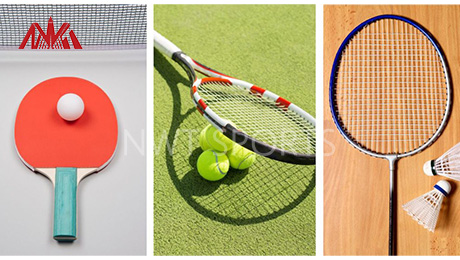Pickleball is one of the fastest-growing sports worldwide, gaining popularity due to its combination of elements from tennis, badminton, and table tennis. Whether you’re looking to improve your pickleball court flooring or simply enjoy a fun game, understanding the differences and similarities between these sports is key. In this article, we’ll compare pickleball court flooring options and other aspects of pickleball with tennis, badminton, and table tennis to highlight why pickleball stands out.
1. Court Size and Layout
· Pickleball: A pickleball court is much smaller than a tennis court, measuring 20 feet (width) x 44 feet (length). This compact size allows for easier accessibility, especially in smaller spaces or recreational settings.
· Tennis: Tennis courts are significantly larger, with singles courts measuring 27 feet (width) x 78 feet (length). Players must cover a large area, requiring more stamina and agility.
· Badminton: A badminton court is similar in size to a pickleball court, measuring 20 feet (width) x 44 feet (length), but the net is higher, and the rules of play differ.
· Table Tennis: The smallest of the four, a table tennis table measures 9 feet (length) x 5 feet (width), requiring quick reflexes but little to no running.
2. Intensity and Ideal Audience
· Pickleball: Pickleball is known for its moderate intensity, making it an excellent choice for beginners, seniors, and those looking for a lower-impact sport. While it offers a good cardiovascular workout, the pace is manageable for most people.
· Tennis: Tennis is much more physically demanding, requiring intense endurance, speed, and power for rallies. It is ideal for athletes looking for high-intensity exercise.
· Badminton: While still a fast-paced game, badminton demands quicker reflexes and agility due to its rapid shuttlecock speed, offering a high-intensity workout similar to tennis.
· Table Tennis: Table tennis requires speed and coordination but places less physical strain on the body compared to tennis and badminton. However, it requires intense mental focus and quick reflexes.

3. Equipment and Gear
· Pickleball: Pickleball paddles are smaller and lighter than tennis rackets. The plastic ball has holes and travels slower than a badminton shuttlecock or tennis ball, making the game more accessible.
· Tennis: Tennis rackets are larger and heavier, and the tennis ball is much more elastic, creating faster and more powerful shots.
· Badminton: Badminton rackets are light and designed for quick swings, while the shuttlecock is aerodynamically designed to slow down in the air, adding an element of precision to the sport.
· Table Tennis: The paddles are small, with a rubber surface that provides excellent spin control, and the ping pong ball is lightweight, making for a fast-paced, skillful game.
4. Skill Requirements and Techniques
· Pickleball: Pickleball is easy to learn, focusing on precision and timing. Key skills include controlling shot placement, using the non-volley zone effectively, and managing the ball’s speed and bounce.
· Tennis: Tennis requires a combination of powerful serves, groundstrokes, and volleys. Skills in serving and rallying are essential, with a focus on hitting deep, fast shots and controlling the pace.
· Badminton: Badminton techniques include quick reflexes, high-speed smashes, and finesse shots such as drops and clears. Players must be able to control the shuttle’s trajectory and adapt to fast rallies.
· Table Tennis: Table tennis requires excellent hand-eye coordination, precision, and the ability to create spin. Players must control the ball’s speed and placement while adapting to quick returns.
5. Social and Competitive Play
· Pickleball: Known for its social nature, pickleball is typically played in doubles and encourages interaction. Its friendly environment makes it perfect for casual play, family activities, and local competitions.
· Tennis: Tennis can be social, but it often requires more individual preparation. While doubles tennis is a team sport, singles matches are more focused on personal skill and fitness.
· Badminton: Badminton is also a great social sport, with both singles and doubles play. It’s widely enjoyed in Asian countries, where many informal games are held in parks or community centers.
· Table Tennis: Table tennis is perfect for both recreational and competitive play, often enjoyed in indoor spaces. Its accessibility and fast nature make it a favorite for community tournaments and leisure play.
Conclusion
· Pickleball’s Advantage: Pickleball stands out for its ease of learning, moderate physical intensity, and strong social element. It’s suitable for players of all ages and abilities, especially seniors and beginners, and provides a low-impact yet engaging workout.
· Tennis’s Advantage: Tennis is the ideal sport for athletes looking for intense physical challenges and higher levels of competition. It requires strength, endurance, and agility, making it a full-body workout.
· Badminton’s Advantage: Badminton’s fast-paced nature and technical skill requirement make it a favorite for those looking to improve their reflexes and agility while having fun.
· Table Tennis’s Advantage: Table tennis is perfect for those who want a fast-paced, competitive game that requires less physical exertion but high mental focus.
Post time: Feb-21-2025
